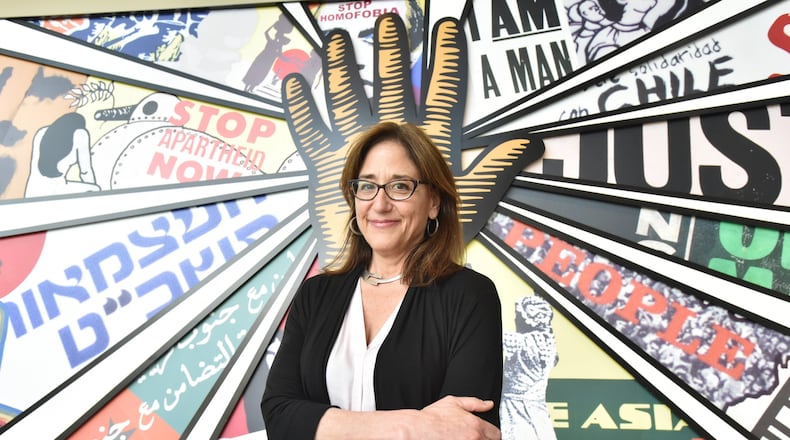Jill Savitt has been campaigning for justice since she was in second grade.
It started with sports. She was carted around to youth baseball games to watch her brothers play and was annoyed to see no girls on the teams.
Can’t a little girl growing up in Ramsey, New Jersey, play baseball?
“I was told I could cheer for them,” said Savitt. “That didn’t seem right.”
She talked her way onto a team, the Beavers, where she first played outfield, then catcher (because in “Tiny Tim” baseball, she said, the outfield is a dead zone). But the discrimination didn’t end.
Her teammates accepted her, but regular slights came from visiting teams. “At the end of a game, nobody shakes your hand,” she wrote in a letter to the editor of the Ramsey-Mahwah Reporter. Batters would turn up their noses and pretend she smelled bad.
“So, if you would, tell everybody, and especially the boys,” she requested. “Write something about us.”
The press came to the rescue. In its June 9, 1977 edition, the Ramsey-Mahwah Reporter extolled the barrier-breaking Savitt and two of her colleagues, who played for the Wolverines and the Squirrels. “Jill encourages other girls to play in Tiny Tim, but only if they’re not scared,” suggested the Reporter.
This spring Savitt, 51, steps up to the plate as the new director of the National Center for Civil and Human Rights (NCCHR), bringing a lifelong devotion to fighting for what’s fair and swinging for the fences.
She arrives at a critical time for the downtown attraction. After opening in 2014, the center had three directors in four years and was only getting about half of its hoped-for attendance—especially compared to the firehose of tourists visiting the adjacent attractions, the World of Coca-Cola and the Georgia Aquarium.
In the meantime, political debate in the U.S. had devolved to the sort of screaming interaction associated with professional wrestling interviews. These are parlous times for an institution devoted to issues.
But she’s not scared.
“Right now, we have a really polarized country,” she said recently, after a day of house hunting. “I see the stage being dominated by the far ends of the spectrum. I don’t hear a lot of conversation going on. I hear a food fight.”
As she spoke, she walked through the third floor of the downtown center, looking chic in high-heeled boots and a chunky enameled silver pendant. The third floor contains “Spark of Conviction,” the center’s human rights exhibit, a visual showplace featuring a chorus of angels and a rogue’s gallery of villains.
As founder and CEO Doug Shipman gathered designers and historians to build the NCCHR from the ground up, he asked Savitt to curate this display. She focused on personalities, giving a human face to the story. “She drove the content and the overall narrative,” said Shipman.
The life-sized images in the exhibit are of people such as Denis Mukwege, of the Congo, a gynecologist who, with surgical repairs, has helped thousands of women recover from the physical damage and emotional trauma of wartime rape. Mukwege shared the Nobel Peace Prize in 2018, recognizing his efforts.
In the changing world of politics, this gallery needs continuous updating. Robert Mugabe, pictured among the villains, is no longer in power in Zimbabwe; Hisseme Habre of Chad, is no longer hiding out in Senegal; he has been convicted of his crimes.
Along with such victories come setbacks.
Savitt pointed to the mural that greets visitors in the lobby of the center. In the upper left-hand corner is a blank space, once filled by the face of Aung San Suu Kyi of Myanmar, a politician who braved years of imprisonment by the military dictatorship there. She became a leader and a Nobel winner.
Yet, under her leadership Myanmar has carried out a brutal campaign against the Rohingya people, an ethnic minority; thousands have been killed and hundreds of thousands driven into exile. “She’s now really complicit in the genocide of a group of her own people,” said Savitt.
Savitt has spent many years working to end genocide, beginning with the Olympic Dream for Darfur, the 2007 campaign that she founded with actress Mia Farrow. During that effort, Savitt’s tiny organization successfully coerced China into reducing support for the government of Sudan, which was conducting a genocidal war against rebels in that country, and convinced China to urge Sudan to cooperate with the International Criminal Court.
Dream for Darfur used China’s concern about the upcoming 2008 summer Olympics in Beijing to help achieve their goals. “We set up a giant international torch relay, parallel to the one that China had going on,” said Savitt. “Ours went through every country that had experienced genocide.”
She went on to serve as interim director of the Simon-Skjodt Center for the Prevention of Genocide at the United States Holocaust Memorial Museum in Washington, D.C.
“She was creative in finding levers to pressure governments,” said Michael Abramowitz, her supervisor at the Holocaust Museum. “Transparently, I’m a big fan of Jill’s.”
Savitt recently gave a workshop on staging such a campaign at the NCCHR’s Baker Street business offices, speaking to members of the staff who wanted to see how she accomplished what she did.
Have a specific, achievable goal, she told the group. Enlist influential allies. (She received support from Steven Spielberg, who she convinced to drop out as an artistic advisor to the 2008 Olympic Games, and eBay founder Pierre Omidyar, who helped fund Dream for Darfur’s effort.)
Savitt never suggested a boycott — “that was a non-starter” — but met nine times with the Chinese government, and translated all Dream for Darfur press coverage into Mandarin.
Savitt wants the NCCHR to become a training center for budding activists who can design their own campaigns, an idea other staffers endorse. “We’re moving past being a place for exhibits,” said Shani Drake, director of marketing. “We want to be thought of as an advocate for advocates.”
Other initiatives sponsored by the center include the LGBT Institute and the International Human Trafficking Institute.
But the center doesn’t forget that it’s a tourist attraction, as well as a local resource. Savitt wants to boost the average annual attendance of 200,000 by expanding programming, screening films and bringing in authors.
“We are busting out of this space,” said Savitt. She would like more room for temporary exhibits, such as the “Breaking Barriers: Sports for Change” exhibit that opened at the center in time for the Super Bowl and helped bump attendance in February to 60,000. (What also helped was a $1 million grant from Coca-Cola that made admission free for the month.)
One place that she would like to see the organization grow is in the programming for families and young children. Right now she said space is too tight to provide a dedicated location for those activities. The original floor plan shrank when the recession of 2008 crimped fundraising.
She has settled in a townhouse in Inman Park, with her significant other, Alexander Parker (a publisher of ebooks), and their black lab, Storm. (Her son, Jackson Wald, attends Kenyon College, where he is sports editor of the college paper.)
She knows it’s early innings at the Center, and she’s eager to put some runs on the scoreboard.
“This is a sacred place,” she said. “It’s a history that people need to know.”
About the Author
Keep Reading
The Latest
Featured







